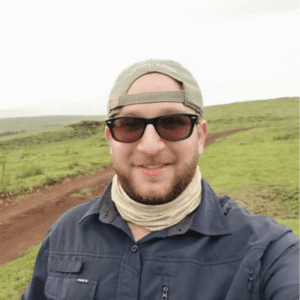
Often described as the ‘greatest show on earth’, the Great Migration in Tanzania and Kenya is an unforgettable and awe-inspiring experience that’s on the bucket list of many visitors to Africa.
This wonder of the natural world is the single greatest en masse movement of animals on the planet. It occurs throughout the year in a continuous clockwise cycle.
If you’re planning on witnessing this natural spectacle, here’s our ultimate guide to the Great Migration.
Every year in East Africa millions of wildebeest and zebras follow the rain, migrating north from the Serengeti plains of Tanzania to the Masai Mara in Kenya in search of grazing and water.
But they’re not alone. Such easy and abundant prey is irresistible to predators also searching for food. Throughout the course of their incredible journey, wildebeest and zebras are closely followed by Africa’s most prolific hunters. Lions, leopards, cheetahs, hyenas and wild dogs track them across the plains, while hungry crocodiles lie wait below the perilous waters of the Grumeti River in Tanzania and the Mara River in Kenya.
The entire journey runs in a clockwise direction covering approximately 3,000 km across the two countries. It’s literally a battle for survival. Each year hundreds and thousands of wildebeest die in the attempt to reach greener pastures.
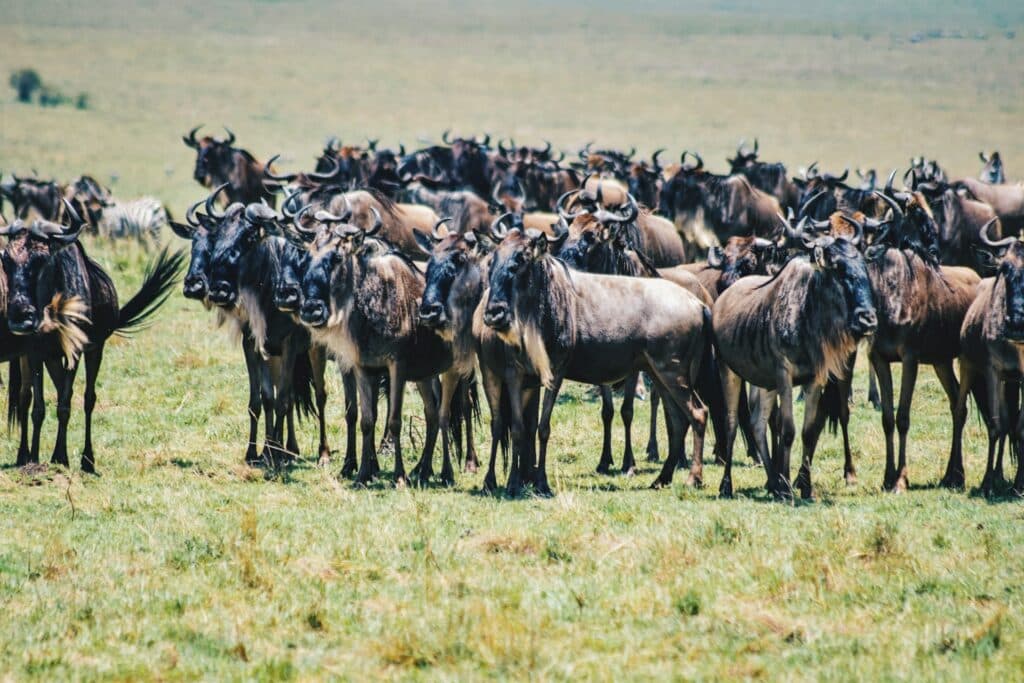
For many visitors, a highlight of the Great Migration is the chance to see one of the dramatic river crossings wildebeest and zebras have to face.
The first crossing happens at the Grumeti River in Western Corridor of Tanzania in June. Drawn to the lush, green grasses of the Serengeti, wildebeest must first face the perils of the Grumeti. The river is home to gigantic Nile crocodiles, the largest freshwater predator in Africa, as well as large groups of hippos.
The hungry crocodiles lie in wait, still and silent beneath the water. As the wildebeest slide down the banks to enter the water, the crocodiles strike, mercilessly. The waters are deep in places, and wildebeest also face the risk of drowning before they get to the other side.
Those who survive must then face an even more perilous crossing further north at the Mara River.
The Mara River, swollen by rains, is a mass of wild currents that are strong enough to sweep away weaker wildebeests. Many animals drown in the swirling waters, panicked and desperate to get to the other side. Others fall prey to the open jaws of hungry crocodiles.
The crossing points themselves are dangerous enough: steep, dusty banks that are easy to slip down. Some wildebeest die in the fall. If they survive the waters and the crocodiles (even the hippos sometimes get in on the action), the wildebeest then have to struggle up the steep, rocky embankments on the other side. Exhausted and beaten, many slip back down, their fight not yet over.
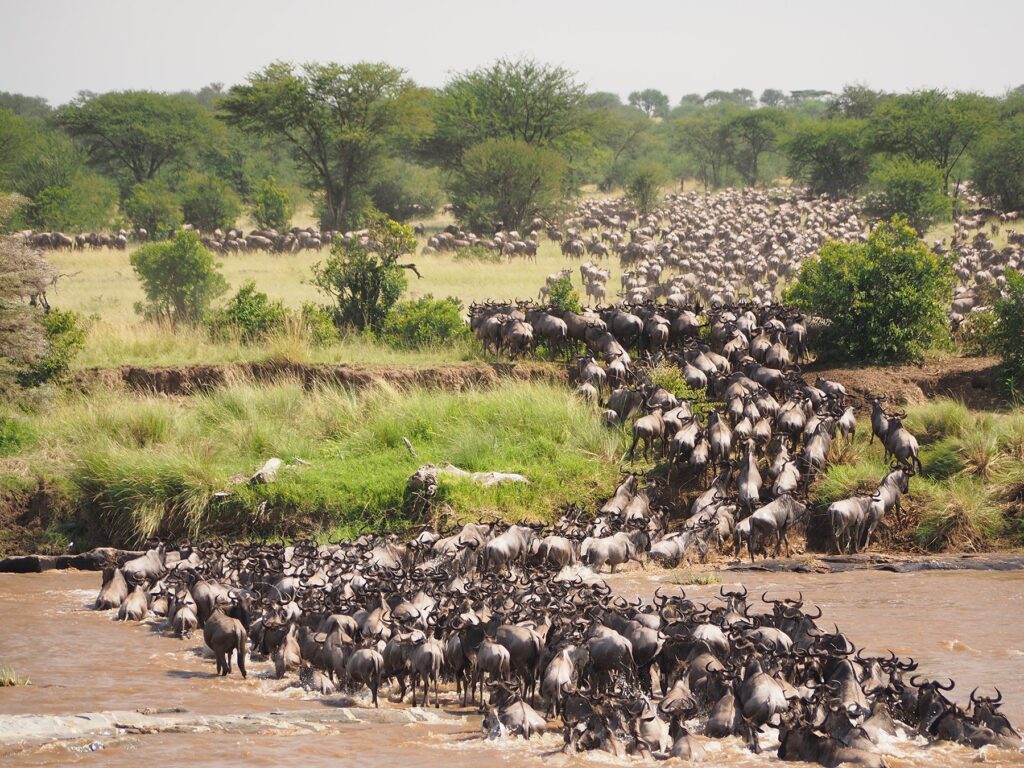
The Mara River crossings are considered one of the most spectacular events on earth. To actually witness one is an experience you’ll never forget. Although it’s heart-breaking to see wildebeest calves and weaker adults battle for survival against bloody-thirsty predators, it’s awe inspiring to witness the natural food chain in action.
The Great Migration is an all-year-round event, and witnessing it depends on what you want to see and whether you want to visit during the rainy or dry season.
The dry season in Tanzania lasts from May to October. The country has two wet seasons. The heaviest rains fall from mid-March to May and are called Masika. Then there are more sporadic rainfalls from November to mid-January called Mvuli.
The dry season in Kenya last from mid-June to the beginning of October, and from late December to mid-March. The wet seasons are from October to December, and from late March to the beginning of June. The wettest months are November, April and May.
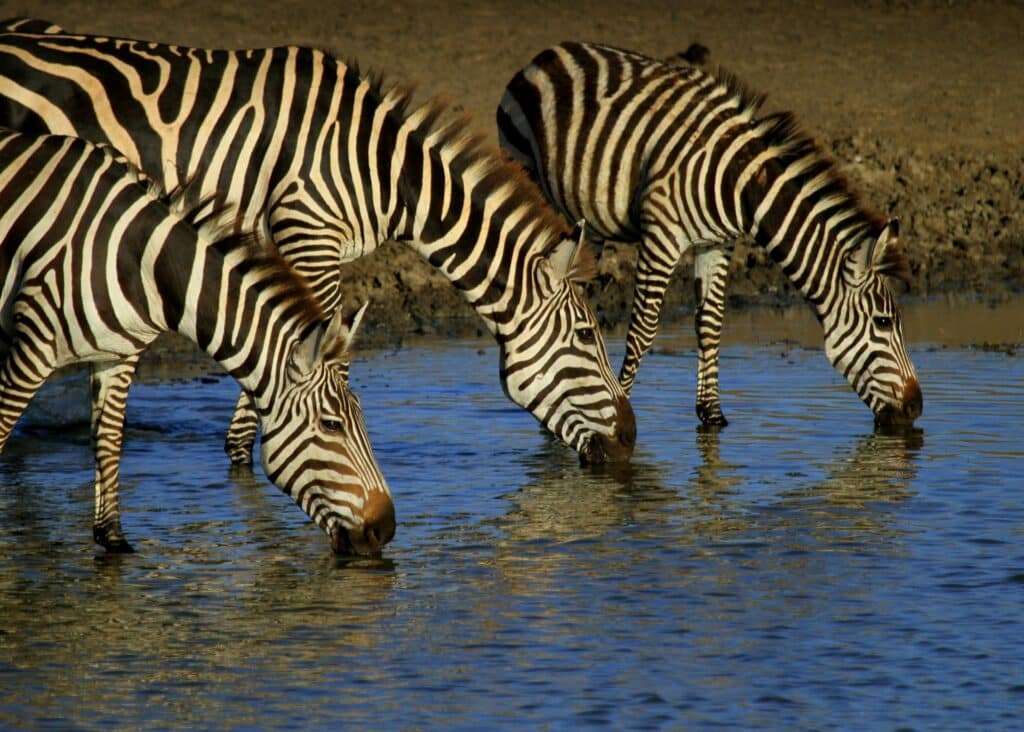
The beginning of the year sees herds congregate on the edge of the Ngorongoro Conservation Area on the southeastern plains of the Serengeti in North Tanzania.
If the recent December rains have been good, the pastures should be lush and green. Herds feed on the nutrient-rich grasses to build up strength and stamina for the long journey ahead. Wildebeest and zebras graze in harmony, the zebras munch on the longer grasses and clear them so wildebeest can graze on the shorter grasses, which they prefer.
January and February also mark a very special time in the Great Migration calendar: calving season. In this period, around 8,000 wildebeest calves are born each day.
The newborn calves are highly vulnerable and are welcome prey for the watchful predators who wait to pounce while mother wildebeests are distracted by grazing. However, the shorter grasses mean it’s easier to spot approaching predators. Newborns are born with strong survival instincts, and can run as fast as the adults at just two days old.
Wildebeest and zebras continue to congregate on the Serengeti plains before gradually moving westwards towards the woodlands of the Western Corridor, where the long rains begin to fall. The rains in this period are particularly heavy and sometimes last right up until June.
This is the least popular time to see the Great Migration. The heavy rainfall makes viewing wildlife particularly difficult, and many of the roads are impassable. The rains also bring an abundance of mosquitoes and a higher risk of malaria for travellers during this period.
Smaller herds join larger groups and merge into one massive movement. May to June is also mating time for wildebeest.
The migration moves north up the western edge of the Serengeti towards the Grumeti Game Reserve and the first river crossing at the Grumeti River. If you want to witness the first river crossing, June is the best time to visit Tanzania, as this is when it usually occurs.
Those who survive the perilous Grumeti River crossing regroup into smaller herds to continue their journey north. In a dry year, the herds begin to arrive in the northern Serengeti at the beginning of July. In a wet year, they may arrive in August.
As the dry season continues, the grasses of the Serengeti begin to turn yellow and the herds head further north towards the Masai Mara in search of wetter, greener pastures.
Before they can cross the border between Tanzania and Kenya to arrive at the Masai Mara National Park, they must face the infamous and perilous mighty Mara River crossing.
Thousands of wildebeest line up along the steep riverbanks that separate the Serengeti from the Masai Mara, ready to take the plunge into the high, turbulent waters of the deep Mara River. Many drown in the fast, racing currents, while others are prey to large, hungry crocodiles.
The crossing is confusing and frantic, as panicked wildebeest desperately try to get to the other side. It’s not something for the faint-hearted, but it’s certainly one of the most dramatic and awe-inspiring sights you’ll ever witness.
Those who make it across must then face the added threat of lions that take advantage of the exhausted and often injured wildebeest making their way to the Masai Mara.
The dramatic Mara River crossings continue up until October when most of the herds reach the northernmost point of their journey in the Kenyan Masai Mara Game Reserve.
As the Masai Mara gets hotter and drier towards October, and the first rains begin back down on the Serengeti, the herds begin to make their way back south, once again facing the perils of the river crossings.
As the rains begin, the weather starts to cool and the herds move southeastwards back towards the Serengeti, where they can graze on the first green grasses of the season. The weather may be unpredictable, but it’s an ideal time to experience the Great Migration as the two seasons merge.
There aren’t as many camps and visitors in this month, but there’s still plenty to see as young lions cubs learn hunting skills and are eager to test them out on the grazing wildebeest and zebras.
December is the most tranquil period of the Great Migration. Heavily pregnant wildebeest and zebras are back on the Serengeti feeding on the lush, sweet grasses of the plains in preparation for calving season in January and February.
The herds spread out and divide into smaller groups and a sense of calm envelopes the area; a short reprieve before the Great Migration cycle starts all over again.
Nature is unpredictable, so it’s not possible to pinpoint exactly where the herds will be at any given time. However, if you want to witness the river crossings, your best chance is between June and October. This is the most popular time of year for visitors, so ensure you book accommodation early to avoid disappointment.
January and February are the months to visit if you want to see calves being born.
The weather is cooler in November and the rains are more sporadic than earlier in the year, so it’s still a good time to come. You’ll also get the added benefit of seeing the first green grasses and wildflowers covering the plains. As the main tourist period has ended, it’s easier to find accommodation and enjoy the Great Migration in relative seclusion.
April and May are the least popular months to visit. Heavy rains make viewing difficult and many of the roads are flooded and impassable.
Witnessing the Great Migration is an unforgettable, once-in-a-lifetime experience. For more information, contact our travel experts at True Travel.
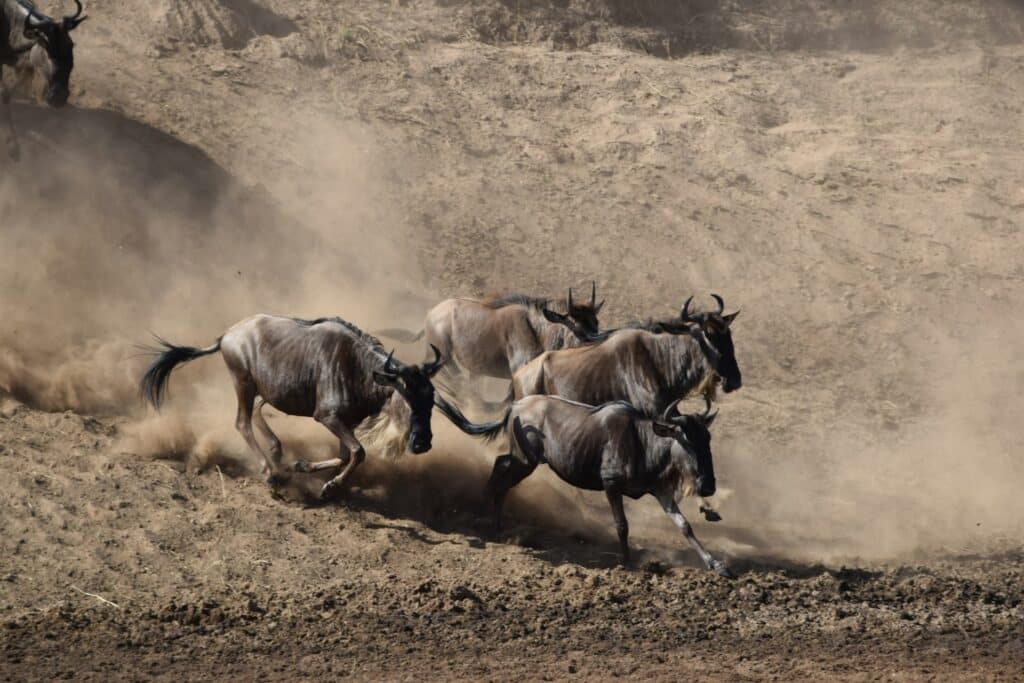
Planning your travel with True starts with you and your ideas, each trip created from a blank piece of paper.
Our Africa specialist’s have created an example travel itinerary to provide a sense of what can be crafted for you for viewing the Great Migration.
7 Day Itinerary
Guide Price: £10,000pp
Guide Price: $12,000pp
Witness the dramatic scenes of the Great Wildebeest Migration unfold in the Serengeti, an incredible wildlife spectacle which can be viewed from different perspectives, be it the luxury of a lodge or from the skies via a hot air balloon.

SIGN UP